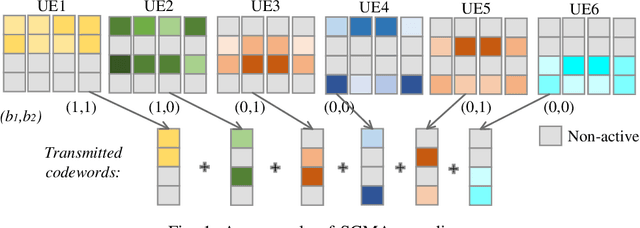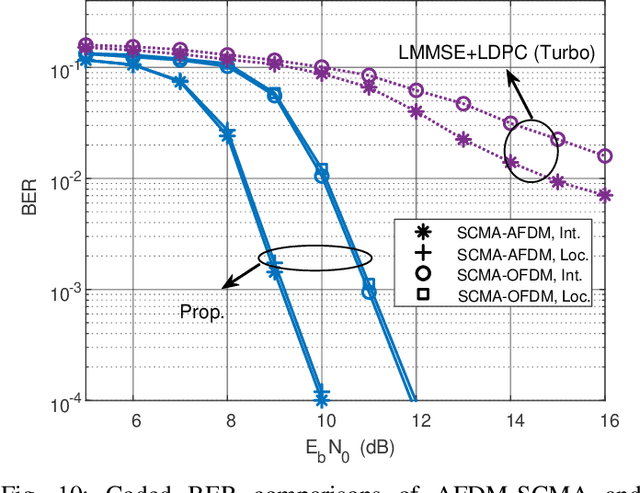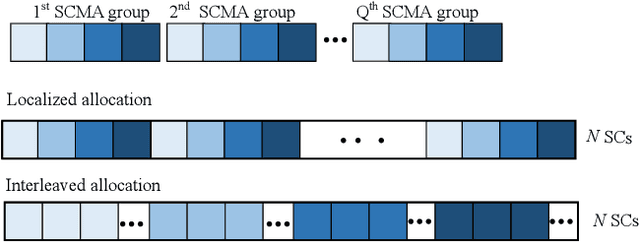Zilong Liu
Shitz
Joint Sparse Graph for Enhanced MIMO-AFDM Receiver Design
Mar 24, 2025Abstract:Affine frequency division multiplexing (AFDM) is a promising chirp-assisted multicarrier waveform for future high-mobility communications. This paper is devoted to enhanced receiver design for multiple input and multiple output AFDM (MIMO-AFDM) systems. Firstly, we introduce a unified variational inference (VI) approach to approximate the target posterior distribution, under which the belief propagation (BP) and expectation propagation (EP)-based algorithms are derived. As both VI-based detection and low-density parity-check (LDPC) decoding can be expressed by bipartite graphs in MIMO-AFDM systems, we construct a joint sparse graph (JSG) by merging the graphs of these two for low-complexity receiver design. Then, based on this graph model, we present the detailed message propagation of the proposed JSG. Additionally, we propose an enhanced JSG (E-JSG) receiver based on the linear constellation encoding model. The proposed E-JSG eliminates the need for interleavers, de-interleavers, and log-likelihood ratio transformations, thus leading to concurrent detection and decoding over the integrated sparse graph. To further reduce detection complexity, we introduce a sparse channel method by approaximating multiple graph edges with insignificant channel coefficients into a single edge on the VI graph. Simulation results show the superiority of the proposed receivers in terms of computational complexity, detection and decoding latency, and error rate performance compared to the conventional ones.
Waveform and Filter Design for Integrated Sensing and Communication Against Signal-dependent Modulated Jamming
Mar 19, 2025Abstract:This paper focuses on an integrated sensing and communication (ISAC) system in the presence of signal-dependent modulated jamming (SDMJ). Our goal is to suppress jamming while carrying out simultaneous communications and sensing. We minimize the integrated sidelobe level (ISL) of the mismatch filter output for the transmitted waveform and the integrated level (IL) of the mismatch filter output for the jamming, under the constraints of the loss in-processing gain (LPG) and the peak-to-average power ratio (PAPR) of the transmitted waveform. Meanwhile, the similarity constraint is introduced for information-bearing transmit waveform. We develop a decoupled majorization minimization (DMM) algorithm to solve the proposed multi-constrained optimization problem. In contrast to the existing approaches, the proposed algorithm transforms the difficult optimization problem involving two variables into two parallel sub-problems with one variable, thus significantly speeding up the convergence rate. Furthermore, fast Fourier transform (FFT) is introduced to compute the closed-form solution of each sub-problem, giving rise to a greatly reduced computation complexity. Simulation results demonstrate the capabilities of the proposed ISAC system which strikes a proper trade-off among sensing and jamming suppression.
Rate-Splitting Sparse Code Multiple Access
Jan 26, 2025Abstract:This paper presents a novel rate-splitting sparse code multiple access (RS-SCMA) framework, where common messages are transmitted using quadrature phase-shift keying (QPSK) modulation, while private messages are sent using SCMA encoding. A key feature of RS-SCMA is its ability to achieve a tunable overloading factor by adjusting the splitting factor. This flexibility enables an optimal trade-off, ensuring the system maintains superior performance across varying levels of overloading factor. We present a detailed transceiver design and analyze the influence of rate-splitting on the overloading factor. Extensive simulation results, both with and without low-density parity-check (LDPC) codes, highlight RS-SCMA's potential as a strong candidate for next-generation multiple access technologies.
Generalized Spatial Modulation Aided Affine Frequency Division Multiplexing
Jan 18, 2025Abstract:Generalized spatial modulation-aided affine frequency division multiplexing (GSM-AFDM) is conceived for reliable multiple-input multiple-output (MIMO) communications over doubly selective channels. We commence by proposing several low-complexity detectors for large-scale GSM-AFDM systems. Specifically, we introduce the linear minimum mean square error (LMMSE) equalizer-based maximum likelihood detector (LMMSE-MLD). By exploiting the GSM properties, we then derive the LMMSE-based transmit-antenna activation pattern (TAP) check-based log-likelihood ratio detector (LMMSE-TC-LLRD). In addition, we propose a pair of new detectors, namely the greedy residual check detector (GRCD) and the reduced space check detector (RSCD). We also derive a bit error rate (BER) upper-bound by considering the MLD. Our simulation results demonstrate that 1) the BER upper bound derived is tight for moderate to high signal-to-noise ratios (SNRs), 2) the proposed GSM-AFDM achieves lower BER than its conventional counterparts, and 3) the conceived detectors strike a compelling trade-off between the BER and complexity.
The KnowWhereGraph Ontology
Oct 17, 2024



Abstract:KnowWhereGraph is one of the largest fully publicly available geospatial knowledge graphs. It includes data from 30 layers on natural hazards (e.g., hurricanes, wildfires), climate variables (e.g., air temperature, precipitation), soil properties, crop and land-cover types, demographics, and human health, various place and region identifiers, among other themes. These have been leveraged through the graph by a variety of applications to address challenges in food security and agricultural supply chains; sustainability related to soil conservation practices and farm labor; and delivery of emergency humanitarian aid following a disaster. In this paper, we introduce the ontology that acts as the schema for KnowWhereGraph. This broad overview provides insight into the requirements and design specifications for the graph and its schema, including the development methodology (modular ontology modeling) and the resources utilized to implement, materialize, and deploy KnowWhereGraph with its end-user interfaces and public query SPARQL endpoint.
Grid Evolution for Doubly Fractional Channel Estimation in OTFS Systems
Sep 26, 2024



Abstract:In orthogonal time-frequency space communications, the performances of existing on-grid and off-grid channel estimation (CE) schemes are determined by the delay-Doppler (DD) grid density. In practice, multiple real-life DD channel responses might be co-located within a same DD grid interval, leading to performance degradation. A finer grid interval is needed to distinguish these responses, but this could result in a significantly higher CE complexity when traditional methods are used.To address this issue, a grid evolution method for doubly fractional CE is proposed by evolving the initially uniform coarse DD grid into a non-uniform dense grid. Simulation results show that our proposed method leads to improved computational efficiency, and achieves a good trade-off between CE performance and complexity.
Oversampled Low Ambiguity Zone Sequences for Channel Estimation over Doubly Selective Channels
Sep 26, 2024Abstract:Pilot sequence design over doubly selective channels (DSC) is challenging due to the variations in both the time- and frequency-domains. Against this background, the contribution of this paper is twofold: Firstly, we investigate the optimal sequence design criteria for efficient channel estimation in orthogonal frequency division multiplexing systems under DSC. Secondly, to design pilot sequences that can satisfy the derived criteria, we propose a new metric called oversampled ambiguity function (O-AF), which considers both fractional and integer Doppler frequency shifts. Optimizing the sidelobes of O-AF through a modified iterative twisted approximation (ITROX) algorithm, we develop a new class of pilot sequences called ``oversampled low ambiguity zone (O-LAZ) sequences". Through numerical experiments, we evaluate the efficiency of the proposed O-LAZ sequences over the traditional low ambiguity zone (LAZ) sequences, Zadoff-Chu (ZC) sequences and m-sequences, by comparing their channel estimation performances over DSC.
Iterative Equalization of CPM With Unitary Approximate Message Passing
Aug 14, 2024



Abstract:Continuous phase modulation (CPM) has extensive applications in wireless communications due to its high spectral and power efficiency. However, its nonlinear characteristics pose significant challenges for detection in frequency selective fading channels. This paper proposes an iterative receiver tailored for the detection of CPM signals over frequency selective fading channels. This design leverages the factor graph framework to integrate equalization, demodulation, and decoding functions. The equalizer employs the unitary approximate message passing (UAMP) algorithm, while the unitary transformation is implemented using the fast Fourier transform (FFT) with the aid of a cyclic prefix (CP), thereby achieving low computational complexity while with high performance. For CPM demodulation and channel decoding, with belief propagation (BP), we design a message passing-based maximum a posteriori (MAP) algorithm, and the message exchange between the demodulator, decoder and equalizer is elaborated. With proper message passing schedules, the receiver can achieve fast convergence. Simulation results show that compared with existing turbo receivers, the proposed receiver delivers significant performance enhancement with low computational complexity.
New Lower Bounds on Aperiodic Ambiguity Function of Unimodular Sequences
Feb 01, 2024Abstract:This paper presents new aperiodic ambiguity function (AF) lower bounds of unimodular sequences under certain low ambiguity zone. Our key idea, motivated by the Levenshtein correlation bound, is to introduce two weight vectors associated to the delay and Doppler shifts, respectively, and then exploit the upper and lower bounds on the Frobenius norm of the weighted auto- and cross-AF matrices to derive these bounds. Furthermore, the inherent structure properties of aperiodic AF are also utilized in our derivation. The derived bounds are useful design guidelines for optimal AF shaping in modern communication and radar systems.
AFDM-SCMA: A Promising Waveform for Massive Connectivity over High Mobility Channels
Dec 18, 2023



Abstract:This paper studies the affine frequency division multiplexing (AFDM)-empowered sparse code multiple access (SCMA) system, referred to as AFDM-SCMA, for supporting massive connectivity in high-mobility environments. First, by placing the sparse codewords on the AFDM chirp subcarriers, the input-output (I/O) relation of AFDM-SCMA systems is presented. Next, we delve into the generalized receiver design, chirp rate selection, and error rate performance of the proposed AFDM-SCMA. The proposed AFDM-SCMA is shown to provide a general framework and subsume the existing OFDM-SCMA as a special case. Third, for efficient transceiver design, we further propose a class of sparse codebooks for simplifying the I/O relation, referred to as I/O relation-inspired codebook design in this paper. Building upon these codebooks, we propose a novel iterative detection and decoding scheme with linear minimum mean square error (LMMSE) estimator for both downlink and uplink channels based on orthogonal approximate message passing principles. Our numerical results demonstrate the superiority of the proposed AFDM-SCMA systems over OFDM-SCMA systems in terms of the error rate performance. We show that the proposed receiver can significantly enhance the error rate performance while reducing the detection complexity.
 Add to Chrome
Add to Chrome Add to Firefox
Add to Firefox Add to Edge
Add to Edge